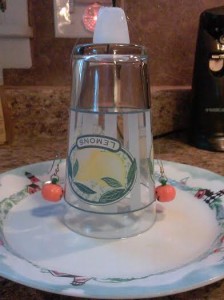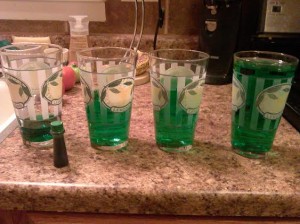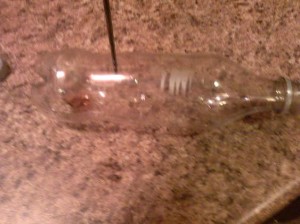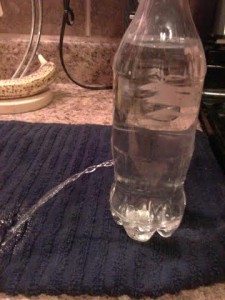5 Cool Science Experiments Using Pretty Much Nothing But Water!
You don’t need to spend a lot of money on science supplies. Heck, with these, all you need to do is turn on the water faucet!
1. Okay, ice is water, right? How do ice skaters glide across the ice so smoothly and quickly? It’s all about the science. Get out a dinner plate and put a large glass on it, upside down. Put an ice cube on the glass.
Cut about 6 inches of fishing line and tie a small weight on each end. The weights do not have to be heavy, but they do have to exert a small pull on the line. I used pumpkin earrings. No, I am not Luna Lovegood, but wouldn’t it be cool if I were? Then again, you’re not really sure, are you? “Oh, it’s all good fun.”
Lay the line on top of the ice cube with the weights dangling down on opposite sides. Wait about five minutes; it won’t take long before the fishing line is slicing through the ice cube. What’s happening here?
It’s the force of the two weights that is causing the fishing line to slice right through the ice cube. The fishing line is being pulled through the ice and melting the ice along the way, just as ice skates pull through the ice, melting it on their path. This allows the skater to go fast, and it makes the journey smooth. Skaters are actually gliding on melted ice, and their moving skates are what is making the ice melt!
2. While I have those glasses out of the cabinet, let’s make a glass harmonica! Just fill several glasses with water and tap them with a spoon, and you’ll have a genuinely beautiful-sounding musical instrument. I put some food coloring in mine so you could see the water levels.
The musical sounds you hear when you tap the glass with the metal spoon are all about sound waves and vibrations. The more water the glass contains, the slower the vibration and the lower the pitch. The glass with the least water will have the highest pitch.
3. Leak Proof Bag – Now, turn on the water faucet again and fill a sandwich bag with water. Seal it up. Make sure you’ve got the seal sealed firmly. If you stick a sharp object through the water-filled bag, all the way through and out the other side, you’ll get a leak, right.
Wrong. According to Steve Spangler and the laws of polymer science, “The plastic bag is made out of long chains of molecules called polymers. This gives the bag its stretchy properties. The sharpened pencils slip between the molecule strands without tearing the entire bag. Believe it or not, the long chains of molecules seal back around the pencil to prevent leaks.” Steve’s words!
4. Rain Inside a Jar – Okay, now get out a big glass jar and a small bowl. Fill the bowl with water and heat it in the microwave for about three minutes. It doesn’t have to boil.
Pour the hot water into the big glass jar and cover it with a dinner plate. Let the plate-covered jar sit there for a minute or two, then dump a tray of ice cubes on the plate. Guess what: it will rain inside the jar!

The ice on the plate will make the plate very cold, which causes the warm air in the jar to condense and form water droplets. This is what the weather person is talking about when he or she describes a “cold front.” When the cold air meets the warmer air, it will rain.
5. Do Not Open Bottle – Lastly, let’s talk about pressure and force. I like to experiment with this in a way that some people might describe as, um, a practical joke. Well, why not?
Take a plastic bottle (any size and type will do, but mine is, of course, a Diet Coke bottle. If you are a child, ask an adult to punch a hole in the side of the bottle with an ice pick. If you’re adult, you may do it yourself.
Cover the hole in the bottle with your finger and fill the bottle with plain ol’ water. Color the water if you wish to make the joke even better. Screw the cap back on and remove your finger from the hole. The water will not leak out. Pick the bottle up and squeeze it even just a little bit. Step back, because the water will pour out! That’s pretty funny when it isn’t you getting your shoes soaked!
Now put this innocent bottle on the counter or in the refrigerator and wait for the yells of outrage.
You can also make the bottle “pour” by loosening and tightening the cap. This would be much kinder than letting someone else pick the bottle up, but it wouldn’t be nearly as much fun. Of course, you are probably nicer than I am.
When the cap is on the bottle, the air pressure in the bottle is equal to the pressure outside the bottle. When the pressure is the same, there’s nothing to force the water to leave the bottle. When you loosen or remove the cap, the water squirts out because the weight of the water has a greater pressure than the pressure outside of the bottle. Even when the cap is on tightly, picking up the bottle will squeeze it just enough to FORCE the water to squirt out.
All of the above experiments are fun, absolutely safe, and use plain water. No added chemicals or expensive devices are necessary. Plain water, plastic bottles, a sandwich bag, a pencil, and a few dishes from your kitchen cabinets. Oh, and a few inches of fishing line and a pair of your best pumpkin earrings. Or radish earrings, if you really ARE Luna Lovegood.
Reminder: be really careful with that ice pick. Ask an adult to do that bit for you, and if you ARE the adult wielding the ice pick, please be careful, too.
These five experiments are by no means the only water experiments. There are thousands! Many of them can be found on our websites and YouTube channels!
I love the simple experiments for many reasons, one of which is that even very young children can safely experiment with science!
 Jane Goodwin is a professor of expository writing at Ivy Tech Community College, a hands-on science teacher for College for Kids, a professional speaker and writer, and a social media liaison for Steve Spangler Science. She wanted to be a ballerina and an astronaut, but gravity got the better of her.
Jane Goodwin is a professor of expository writing at Ivy Tech Community College, a hands-on science teacher for College for Kids, a professional speaker and writer, and a social media liaison for Steve Spangler Science. She wanted to be a ballerina and an astronaut, but gravity got the better of her.








Love these experiments. Please send more.
OMG! brilliant work JANE GOODWIN. I have never ever seen any Blog related to this Specific Work. what work and use of water all the Practical work have some scientific methods behind them.
and i really love this Blog, and very hope full many more.
My kids loved them and I am only 16
Your a parent a sixteen???
this things are cool for our kids
Love these! Thank you!
great work………..these were cool
Such a cool experiment ooooooooffffff
wow these are really cool I am totally speechLESS
omg i love this thanks so much
thanks for the ideas
WOW ALL OF THEM WORK INCREDABLE !!!!!!!!!!:) WOW !!!!!!!!!!!!!!!!!!!!!!!!!!!!!!!!!!!!!!!!!!!!!!!!!!!!!!!!!!!!!!!!!!!!!!!!!!!!!!!!!!!!!!!!!!!!!!!!!!!!!!!!!!!!!!!!!!!!!!!!!!!!!!!!!!!!!!!!!!!!!!!!!!!!!!!!!!!!!!!!!!!!!!!!!!!!!!!!!!!!!!!!!!!!!!!!!!!!!!!!!!!!!!!!!!!!!!!!!!!!!!!!!!!!!!!!!!!!!!!!!!!!!!!!!!!!!!!!!!!!!!!!